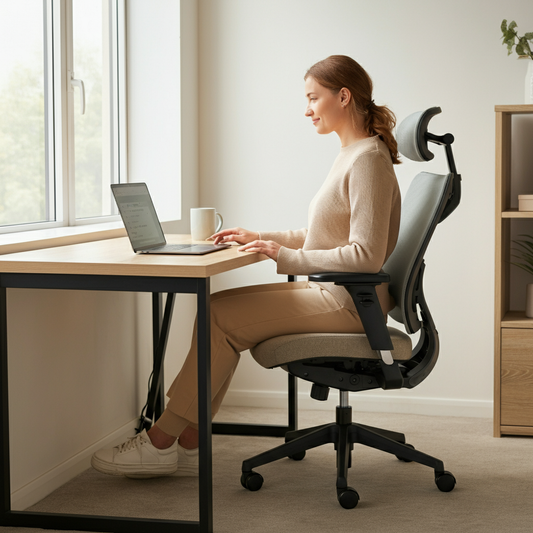An ergonomic office chair is a fantastic tool for improving posture, alleviating discomfort, and enhancing productivity. But even the best ergonomic chair won’t deliver its full range of benefits if it’s improperly used. Many people unknowingly make simple mistakes when setting up or using their chairs, leading to avoidable aches and poor ergonomics.
To help you unlock the full potential of your chair, we’re uncovering five common ergonomic chair mistakes and providing actionable tips to fix them. By following these guidelines, you can create a workstation setup that supports your comfort and well-being. For quality adjustable options, take a look at Lundia’s collection of ergonomic office chairs, designed to make these adjustments simple and effective.
Mistake #1: Incorrect Seat Height
Why It’s a Problem:
If your seat is too high or too low, your legs and lower back bear the brunt of the discomfort. A poorly adjusted seat height can lead to circulation problems, misaligned posture, and strain on your thighs and lower back.
How to Fix It:
- Adjust the seat so your feet lie flat on the floor and your knees bend at a 90-degree angle.
- Ensure your thighs are parallel to the floor and maintain a small gap (about two fingers) between the back of your knees and the seat edge.
- If your desk is too high for your adjusted seat height, consider a footrest to maintain proper alignment.
Lundia’s PostureMax Office Chair offers an extended height range, making it easy to achieve optimal positioning for all heights.
Mistake #2: Poor Lumbar Support Alignment
Why It’s a Problem:
Lumbar support is a key feature of an ergonomic chair, yet it’s often neglected or improperly adjusted. Misaligned lumbar support fails to maintain the natural curve of your lower back, leading to slouching and back pain.
How to Fix It:
- Locate your chair’s lumbar support feature, often integrated into the backrest.
- Adjust it so it fits snugly into the curve of your lower back, right above the pelvis.
- If your chair lacks adjustable lumbar support, consider investing in a lumbar support chair like Lundia’s ErgoActive Mesh Chair, designed to provide ergonomic precision for better posture.
Mistake #3: Ignoring Armrest Positioning
Why It’s a Problem:
Armrests are essential for minimising arm and shoulder strain, yet they are often positioned too high or too low. This can result in tense shoulders, wrist discomfort, and even neck strain.
How to Fix It:
- Adjust the armrests so your elbows are bent at a 90-degree angle, with your arms comfortably resting.
- Ensure the armrests are neither too high (pushing your shoulders up) nor too low (causing you to slump).
- Use armrests to support your arms without interfering with your ability to tuck in close to your desk.
For multi-position armrests, check out the ErgoMesh Task Chair from Lundia, which offers flexibility to suit all needs.
Mistake #4: Skipping the Backrest Tilt Adjustment
Why It’s a Problem:
Many people sit with their backrests too upright or reclined too far back, causing unnecessary strain on their spine. Failing to adjust the backrest tilt can compromise both comfort and posture.
How to Fix It:
- Set the backrest to an angle between 100–110 degrees for optimal comfort and spinal alignment.
- Ensure your entire back remains in contact with the backrest, particularly your lower back.
- Use the recline function periodically throughout the day to introduce movement and reduce static postures.
Lundia’s ErgoActive Mesh Chair includes a recline feature to maintain back support through various positions.
Mistake #5: Overlooking Seat Depth
Why It’s a Problem:
A seat that is too shallow or too deep can create pressure points, restrict circulation, or reduce back support. Many users are unaware of this critical adjustment point.
How to Fix It:
- Sit back so your lower spine aligns with the backrest.
- Adjust the seat depth so the edge of the seat is approximately two fingers’ width away from the back of your knees.
- Choose a chair with sliding-seat functionality, like Lundia’s Classic Comfort Chair, to accommodate varying leg lengths.
The Importance of Proper Ergonomic Chair Adjustment
Fixing these five common mistakes can considerably improve your posture, comfort, and productivity. Here’s why each adjustment matters:
- Posture: Correct positioning prevents slouching and supports the natural curves of your spine.
- Comfort: Adjustments tailored to your body reduce tension, fatigue, and pain during prolonged sitting.
- Health: A well-aligned chair setup promotes circulation, decreases the risk of musculoskeletal issues, and supports long-term mobility.
Why Choose Lundia’s Ergonomic Office Chairs?
With over 40 years of experience, Lundia has earned its reputation for delivering ergonomic seating solutions that don’t compromise on quality or functionality. Their chairs feature adjustable settings, robust support, and innovative designs that cater to different body types and work environments.
Explore Lundia’s ergonomic office chair collection to find your perfect match, whether you’re looking for a breathable comfortable task chair or a premium lumbar support chair.
Final Thoughts
Don’t let simple ergonomic mistakes undo the benefits of your chair. By fine-tuning the height, lumbar support, armrests, backrest, and seat depth, you can optimise your workspace for comfort and health. The right adjustments combined with a high-quality ergonomic chair—like those from Lundia—can make all the difference.
Take the first step towards better posture today and explore Lundia’s range of chairs to upgrade your workspace effortlessly.




